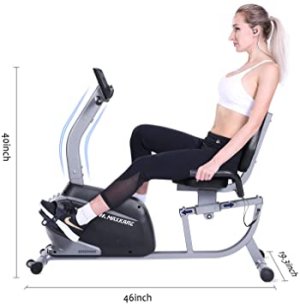MaxKare Recumbent Exercise Bike Review
So, I recently decided I need to do some exercise.
I know, it was a shock to my system, but exercise has never really been my thing.
To be fair, I did use to do a fair amount of cycling in my 20s (I even cycled to work a couple of times, which was a 15-mile ride in each direction), but then I did almost nothing until I moved to the USA in 2005 when my late wife bought us a Sole TT9 Treadmill.
We both used to use it every day, slowly building up the distance and duration – until winter struck and the room got too cold to be in. (Yes, I know that’s not a great excuse).
Then time went on, and the room filled up with so much stuff (my wife was a hoarder), that we could no longer get to the treadmill, even if we’d wanted to.
Fast forward to 2020, and since my wife’s death in late 2018, I have been trying to tidy up the house as best I can – donating her clothes to somebody else, giving things away to friends that I will never use, and throwing out old stuff that was way past its expiry date.
And lo and behold, I uncovered the treadmill again.
However, my attempts to get it working, after a lapse of probably over ten years, were not successful – it would power up and start moving for about ten seconds, then it cut out with an error message I couldn’t track down.
I tried contacting the company, but they were not a great deal of help.
So, time for Plan B!
I thought I’d get myself a recumbent exercise bike, which seemed like it would be easier for me these days. (I used to have a more standard style of exercise bike back in the 1980s or 1990s, which I used for a while, so I knew it was a piece of equipment I could and would use.)
After doing a fair amount of research on Amazon, I finally chose a MaxKare Recumbent Exercise Bike.
I’d been looking to spend no more than $200 on one, but this did cost a little bit more than that, but since the shipping was free (it wasn’t on Prime), I went ahead anyway.
So, it came fairly quickly (even though it wasn’t on Prime), and then I was faced with the job of assembling the thing – not my favourite activity.
Once I managed to get everything out of the box – see, I told you it wasn’t my thing – I opened up the short installation guide that came with it.
At first, I was horrified by the exploded parts diagram I found – it seemed like there were hundreds of bits.
However, on closer inspection, I realized many of those parts were pre-assembled (e.g. in the flywheel housing).
There are, then, just eight steps to putting the bike together, and the only tools you need (i.e. a multi-size spanner, or wrench as Americans call it, and an allen key) are included.
The instructions are clear enough for somebody with my lack of experience to cope with, and something I thought was a particularly nice touch, and which I’d never seen before (not that I make a habit of buying things I need to assemble) was the fact that all of the nuts, bolts, washers, and screws that you need for each of the eight steps were in their own individual and numbered bags.
I’ve bought things before where all of those components come in one large bag and it’s up to you to work out which is a #4 bolt or a certain size of screw, and that might be fine if you know what you’re doing, but I’m not one of those people.
Separating all those accessories like this was such an obvious but genius thing to do.
The assembly, then, went reasonably well.
There was one screw that I was unable to get to fit in the pre-drilled holes, but I decided not to worry about it, which is because it was required for what would, on a normal bike, be the handlebar stem.
On this bike, there should be four screws that attach that upright to the base – one on the left, one on the right, and two at the rear.
However, after a long time trying to get the screw on the left to go in, I gave up, concluding that three of the four should be sufficient, given that the upright was not really going to take any great stress, because it’s really only there to hold the computer / monitor panel. (There are token handlebars, but they would only be of any use if you were using the bike in a non-recumbent position – something I wasn’t planning on doing.)
Once I got past that stumbling block, the next hurdle was connecting the tension cable to the tension wheel.
The instructions for how to do that were accurate – but they didn’t mention just how much pressure you needed to apply to join the tension cable to the control knob.
Once I took the plunge (based on somebody else’s review on Amazon) and really pulled on the cable, it snapped into place and after that, the rest was plain sailing, which meant I soon had my bike set up and ready to roll.
I tried it out immediately, of course, and was pleased to find that:
- It appeared to work, which suggested I’d followed all of the instructions correctly.
- It was more stable than I thought it might be, especially as I’ve set this up on my covered back porch, where the decking is not quite as even as it should be after all these years.
- The seat is easily adjustable and locks into place securely, which means this bike is suitable for people of different sizes.
- The seat and backrest were comfortable enough – although I’ve not used the bike for periods of more than ten minutes yet.
So, here’s my experience to date (after a fortnight or so):
- On the basis that I’m far from fit and not used to doing any exercise, I opted to set a daily goal of just five minutes, for now at least. (This is in part based on an excellent book I read recently, called Mini Habits by Stephen Guise.)
- I’m only using it on the setting with the least resistance (there are eight levels available), because my main goal, initially, is simply to get my body moving. (I spend a lot of time on the settee, which is where I work, eat, and relax.)
- As one reviewer said, the computer monitor thingy is somewhat basic, but that’s not important to me. The instruction “booklet” that comes with it is in pidgin-English and not that helpful, but fortunately, one of the Amazon reviewers detailed what you really need to know.
You can show total time, speed (which is in kilometres per hour, with no apparent way to change that to miles per hour), distance covered (also in kilometres), calories burned (which I’m assuming is far from accurate), another odometer reading (which so far seems to be the same as the first one), and your pulse rate (if you grab the handlebars to the left and right that contain some metal plates which presumably have some electronic device inside).
For me, I’m only really interested in the time and distance – as I said, I’m trying to do at least five minutes (where I don’t care about the speed at all) or at least one mile (but since one mile is 1.6 kilometres, I tend to round it up to 2 kilometres).
- The computer monitor has a rest for a tablet, which I’ve not used yet, but once I start cycling for longer each day, I do plan on either reading a (Kindle) book or watching a video (which may be business-related, or simply a TV show or movie), which is why I also recently bought an Android tablet, purely to use outside for entertainment purposes.
- Since I have set this up on the back porch, it also gets me a bit of fresh air, and I get the opportunity to sit there and look at the scenery.

Since the bike is effectively outside, I have also bought a motorcycle cover to use when the weather is not so great, but as I write this, in late spring, it’s about as good as it gets – not cold, not too warm, and with the worst of the spring winds behind me.
Conclusion
After just two weeks of use (which I realize is not a lot), I think I am already seeing minor benefits:
- I don’t feel as breathless at the end – and I know, five to ten minutes shouldn’t really be long enough to lose my breath, but like I said, I’m out of shape.
- My pulse rate is returning to my resting rate faster than it did when I started doing this exercise, which I find encouraging because as far as I know, one of the signs of fitness is how quickly your heartbeat returns to normal.
I do my brief bit of cycling early in the morning – typically around 8:00am (or earlier), because I know that, once I get into work mode, the chances of me taking a break to do my exercise are slim.
And, of course, at the moment, the heat is less aggressive at that time of day than it would be later on, although on a few days, I have gone out again in the evening, when it’s cooled off but is still light) to do a little bit more pedalling.
My plan is to continue doing my daily exercise, either on this bike or on the treadmill (which I did manage to get working again after a friend suggested it may be the power supply that was faulty, and he was right – I swapped out the surge protector it was plugged into, that being a necessity where I live with frequent power outages), and over time, I shall probably set more demanding goals, but for now, I’m happy that I’m just doing something.
The real test will be when winter comes – since it’s outside (albeit on the covered porch), mainly because I don’t have space for it indoors, then will I still feel like going out and doing my daily exercise?
My hope (and expectation) is that, by then, this will have become a habit and I won’t need to think about it too much.
So, based on what I’ve found so far, I would recommend this MaxKare Recumbent Exercise Bike – it’s not too expensive, as these things go, the assembly was relatively straightforward (and would be faster and easier for those used to doing such jobs), it works fine (for what I need), and, most importantly, as far as I am concerned, it is helping me get some exercise.
Additional Resources
These are suggestions for those who wish to delve deeper into any of the above:








